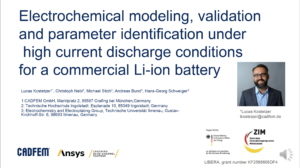Summary:
Extreme scenarios of high discharge current must be understood for better battery management system design. Physics-based modeling can give a better insight into the battery response compared to equivalent circuit models but can be challenging due to the large number of parameters. In this work, an electrochemical pseudo-2D model is developed and used in the parameter identification and validated under high current discharge conditions. Commercial 18650 cells (1.5 Ah) with maximum rated current of 20 A (13.3 C) are characterized with discharge rates up to 40 C under controlled thermal conditions. The proposed three-step parameter identification procedure uses only the measured cell voltage and starts with the open circuit voltage being used to estimate the equilibrium potentials lithiation limits. In the second step, kinetic parameters are evaluated under high current using parameter sensitivity analysis. The correlation of the model parameters with the cell voltage and discharge capacity is explored and shows that for very high current, the limiting conditions change from diffusion process to ohmic related ones. Finally, a parameter optimization with an evolutionary algorithm is applied using two discharge currents as reference (10 A and 30 A). Results are verified with further operating points ( 1.35 A, 20 A, 40 A, 50 A) by comparing simulation results with measurements resulting in a root main square error under 89 mV, and a capacity error under 4%. Limits of the model are explored in the 50 A (33.3 C) case, where a parameter re-fit shows that polarization effects change for very high current.
We are happy to forward your request / feedback.

